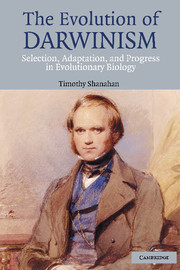3 - For Whose Good Does Natural Selection Work?
Published online by Cambridge University Press: 18 December 2009
Summary
Birds' wings are obviously “for” flying, spider webs are for catching insects, chlorophyll molecules are for photosynthesis, DNA molecules are for. … What areDNA molecules for. … [This] is the forbidden question. DNA is not “for” anything … all adaptations are for the preservation of DNA; DNA just is.
(Dawkins 1982a, p. 45)Introduction
Natural selection operates by favoring those individuals whose characteristics confer any slight advantage in what Darwin termed “the struggle for existence.” As selection operates generation after generation, distinguishing the fit from the less fit, adaptations evolve and are passed on to offspring, which in turn engage in the struggle anew, resulting in “the improvement of each organic being in relation to its organic and inorganic conditions of life” (Darwin 1859, p. 84). Hence the astounding array of complex adaptations characterizing living things. On this all evolutionists agree.
Darwin maintained again and again that “natural selection works solely by and for the good of each being” (Darwin 1859, p. 489; 1959, p. 758). But there are many “beings” involved in the evolutionary process. By whose and for whose “good” does natural selection work? As we have seen, although Darwin generally thought of selection as operating on and for the good of organisms (i.e., as improving the adaptations characterizing the individual organisms constituting an evolving lineage), when the situation warranted it he was also willing to countenance selection operating and forging adaptations at the level of communities or groups.
- Type
- Chapter
- Information
- The Evolution of DarwinismSelection, Adaptation and Progress in Evolutionary Biology, pp. 63 - 90Publisher: Cambridge University PressPrint publication year: 2004



